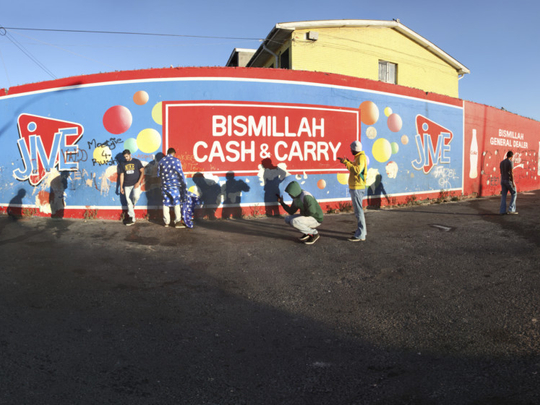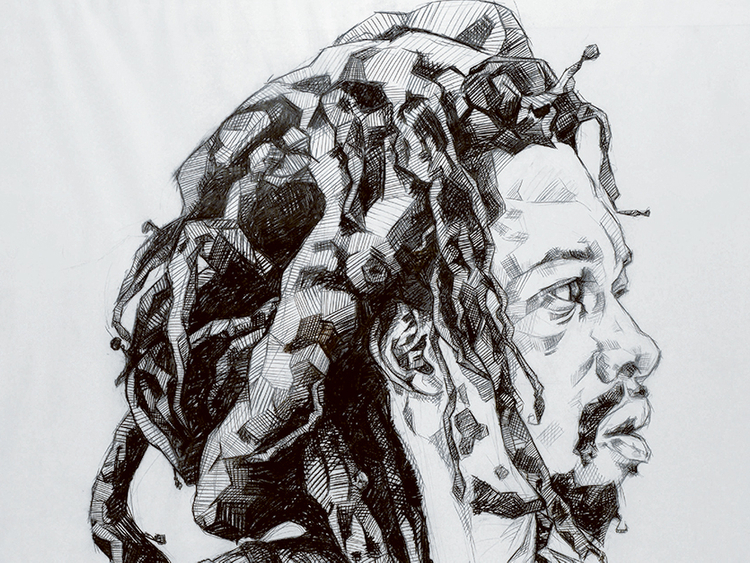
In their previous work, South African artists Hasan and Husain Essop have explored various issues regarding their identity as third generation Indian immigrants and Muslims growing up in South Africa. The latest exhibition by the twin brothers, “Unrest”, focuses on the uneasiness that pervades our society today.
The work, which was created as part of the Standard Bank Young Artist Award for Visual Art in 2014, is very personal, but it addresses global issues of terrorism, cultural stereotyping and xenophobia. The artworks include photographic works, videos and an installation.
The photographic works in this show are images of performances staged by the artists at various locations in Cape Town. The identical twins appear in the pictures in multiple roles, recreating sinister situations based on real life incidents as well as imagined scenarios. They use a special technique to get 360° views of their chosen landscapes, and then merge and blend hundreds of images to create aesthetic yet disturbing panoramas. Each photograph tells a personal story, but one that most people can relate to.
“As middle class, male, Indian-origin Muslims living in Cape Town, we can never feel relaxed or safe because we always have to be on our guard against attacks motivated by economic, racial or religious reasons. But with the ongoing conflicts in various regions, the situation is quite similar around the globe, and ‘unrest’ has become a commonly used word in the media. This body of work deals with violence and the responses to it from historical times to the present. It is based on what is happening in our hometown and tells personal, yet universal stories through our eyes and our bodies,” Hasan Essop says.
The artists have carefully selected locations around Cape Town for staging their performances. In “Athalone Suprette”, they have recreated a recent attack on a mini supermarket in the Athalone area. “This area on the dark, gloomy back of Table Mountain has mass housing projects, and is rife with poverty, crime and gangsters. Such attacks on mini supermarkets, which are owned by recent immigrants, happen frequently. This work is very personal because we grew up in this area, and our grandfather and father ran such businesses when they first immigrated to South Africa,” Husain Essop says.
In another work they have depicted the sinister atmosphere around another supermarket called Bismillah Cash and Carry. Here the brothers are seen enacting the roles of drug dealers and gangsters who hang out in the area, and of young people who get influenced by them.
“This is a very dangerous area, so we had to finish our shoot very quickly. In this work we have some shadows that do not correspond with the figures. These allude to the darkness within people, and the friends we have lost to petty crime in a world where human life has no value. The title of this work, ‘786’, is the numerical representation of ‘Bismillah’; but it also refers to the numerical names of the gangs that rule the prisons in South Africa, and infect these areas with crime,” the artists say.
Similarly, in “Night Patrol”, the brothers enact the roles of a community night patrol, keeping watch over a billboard wishing Muslims on the occasion of the Haj. The stark contrast between the images of the Kaaba, and the pious, peaceful message on the billboard and the atmosphere around it tells a sad story.
In other works, the artists have explored the impact on the psyche of coping with a constant state of paranoia, and depicted various active and passive ways in which people have dealt with it in the past and now. In “Silat Mulut” they have depicted young people practising the Indonesian martial art form of Silat Mulut in a mosque. And in “Freedom Fighters”, they have played the roles of young men training in an open air public gym, with their camouflage clothing and a sign saying “Jihaad training from 8am to 1pm”, proclaiming their intentions.
“Silat Mulut is a martial art rooted in Islam, which helps practitioners physically, mentally and spiritually. This image is inspired by an initiative started by a mosque in Cape Town to empower people to defend themselves and provide them with an outlet for the stress. This is a passive, peaceful, therapeutic way of dealing with the problem; whereas the other image speaks about the possible option of actively going after the criminals and bringing them to book,” the artists say.
The two videos in the show, “Chest Beating” and “Self Flagellation”, refer to the ritual of Ashura and similar historical practices in other religions, to highlight a response to violence that involves self-inflicted pain as a way of empathising with the suffering of others.
The installation titled “The Promise” is linked to the videos, and all the other works, and is perhaps the most personal work in the show. It features two faceless and limbless men, draped in camouflage robes, reaching out to one another with their invisible hands in the presence of the Quran, placed in a beautifully carved box, representing the Holy Kaaba.
“In childhood, whenever we were mischievous or fought, our mother made us swear on the Quran and promise to tell her the truth and to be good. It was a symbolic gesture but got the desired result because we respected the Quran and the values it teaches. The figures in this work appear sinister because they reflect the violence, jealousies and immorality within us. They express the idea that the jihad is a fight with the self, not with others, and that we must make and keep the promise to fight this inner battle. Rather than fighting over religion, people should follow what religion teaches us and work towards resolving the conflicts and schisms that exist in society today so that we can live together harmoniously,” the artists say.
Jyoti Kalsi is an arts-enthusiast based in Dubai.
“Unrest” will run at Gallery Isabelle van den Eynde, in Al Quoz, until January 7, 2016.
Portraits of different cultures
Dubai-based Iranian art collector Farhad Bakhtiar is showcasing selected works from his impressive collection of contemporary Iranian and African art in a series of exhibitions titled “Iran/Africa: Visual Dialogues”.
“I want to add value to the arts scene in Dubai by sharing my collection and by promoting young artists from around the globe. I hope that art will serve as a silent language to better understanding and appreciation of two rich and different cultures,” Bakhtiar says.
The first show in the series is curated by Fereydoun Ave, and features large charcoal portraits on paper and mixed media works on canvas by Amartey Golding. The young London-based artist is of Scottish and Ghanaian descent and his work is influenced by the various cultures he has been exposed to through his parents and his Jamaican stepfather.
Golding’s first show in Dubai was in 2009 at Showcase gallery. He returned in 2012 as the first participant in Tashkeel’s residency programme, during which he developed his own mythological world, Gabosia, to explore the line between reality and storytelling.
“When I saw one of the portraits he had done at a gallery, I was mesmerised. It stayed in my mind and compelled me to start collecting his work. I met him on my next visit to London. He was studying architecture at Central Saint Martin’s School, but I encouraged him to continue drawing portraits and have an exhibition in Dubai. I am happy to see that he has grown as an artist and has shown his work in various countries,” Bakhtiar says.
The show will run at JAMM art gallery, Al Quoz, until December 31.














